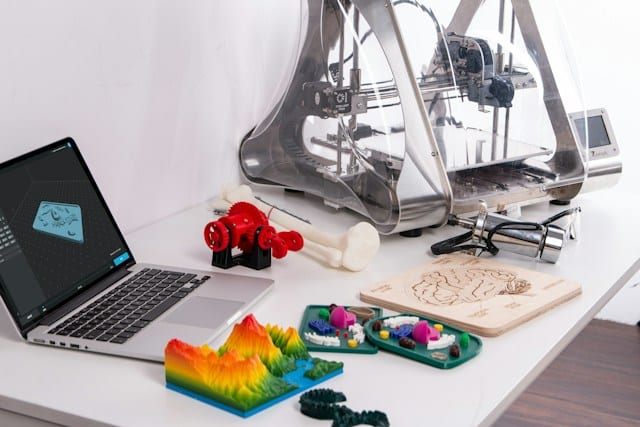The aerospace industry has always been a pioneer in embracing innovative technologies to overcome the dynamic challenges it faces. The constant quest for efficiency in manufacturing aircraft components and parts has led to the adoption of the latest technology: additive manufacturing, also known as 3D printing. But, has this revolution in manufacturing truly transformed the way aerospace operates? The answer, quite simply, is a resounding yes.
The Role of 3D Printing in Aerospace Manufacturing
With its capability to design and produce complex parts while reducing costs, waste, and time, 3D printing technology has found its place within the aerospace industry. The production of aircraft components has benefited immensely from this technology, streamlining processes and enhancing overall efficiency.
Cela peut vous intéresser : How are generative AIs redefining the boundaries of creativity ?
In traditional manufacturing, components are carved or forged out of bulk material. This process not only consumes a lot of material but also wastes a considerable amount. In contrast, additive manufacturing only uses the material necessary to construct the part, layer by layer, hence drastically reducing material waste.
3D printing also proves advantageous when it comes to creating complex components. Traditional manufacturing methods can struggle to produce intricate designs due to their limitations. However, 3D printing technology can easily overcome these barriers and fabricate parts of any complexity.
A lire aussi : How can AI improve disaster preparedness and response?
Enhancing Aircraft Performance with 3D Printed Parts
The aerospace industry is always on the lookout for advancements that can enhance aircraft performance. Given the ability of 3D printing to create complex, lightweight components, it’s no wonder that aerospace has adopted this technology with open arms.
Weight is a critical factor in the efficiency of any aircraft. A reduction in weight leads to a decrease in fuel consumption, which not only reduces costs but also lessens the environmental impact. 3D printing allows for the production of parts that are not only strong and durable but also significantly lighter than their conventionally produced counterparts. This ability to produce lightweight components can significantly enhance aircraft performance, making 3D printing an invaluable tool within the industry.
Furthermore, 3D printed parts can be designed to be more aerodynamic, further improving performance. Traditional manufacturing might find it challenging to fabricate such designs, but 3D printing can accomplish this with ease.
Material Considerations for 3D Printing in Aerospace
In the aerospace industry, the choice of materials is pivotal. These materials need to survive extreme conditions, withstand high pressures, and resist corrosion while being lightweight. 3D printing technology has the capability to handle a wide range of materials, opening up a new realm of possibilities for aerospace manufacturing.
Titanium and its alloys are commonly used in aerospace due to their high strength-to-weight ratio and corrosion resistance. 3D printing can handle this material effectively, providing the industry with more design freedom and cost-effective production methods. Additionally, other high-performance materials such as Inconel, a nickel-chromium-based superalloy, can also be 3D printed, offering the industry even more options when it comes to manufacturing aircraft parts.
Streamlining the Supply Chain with 3D Printing
In addition to enhancing production efficiency and aircraft performance, 3D printing also revolutionizes the supply chain in the aerospace industry. Traditional supply chains can be complex and lengthy, involving multiple stakeholders and stages. This complexity often leads to delays and increased costs.
However, with 3D printing, parts can be produced on demand, effectively reducing stockpile costs and waiting times. This shift towards a more responsive, just-in-time production model streamlines the supply chain, reducing overheads and improving service levels. Also, since 3D printing allows for remote manufacturing, parts can be produced closer to where they are needed, reducing transport costs and lead times.
While it’s clear that 3D printing is revolutionizing the aerospace industry, it’s equally important to understand that the technology is still evolving. As advances in 3D printing continue to emerge, its impact on the aerospace industry will only increase, further pushing the boundaries of what’s possible in aerospace manufacturing and design.
Boosting Energy Efficiency and Rapid Prototyping with 3D Printing
One of the most crucial yet less talked-about benefits of 3D printing in the aerospace industry is its potential to enhance energy efficiency and facilitate rapid prototyping. The aerospace industry, which is one of the biggest consumers of energy, is always seeking ways to curtail energy consumption and reduce its environmental footprint. Here, 3D printing comes as a game-changer.
3D printing technology, with its efficient and precise manufacturing methods, minimizes energy consumption during the production process. Unlike traditional manufacturing techniques that require extensive energy for carving and forging bulk materials, 3D printing constructs parts layer by layer, using only the necessary amount of energy. This not only cuts down on energy use but also significantly reduces material waste, contributing to a more sustainable aerospace industry.
In addition to boosting energy efficiency, 3D printing also enables rapid prototyping in the aerospace sector. Having the ability to create quick and accurate prototypes is key in an industry that is continually evolving and pushing boundaries. Aerospace manufacturers can leverage 3D printing to create detailed models within hours, as opposed to weeks or even months with traditional methods. This not only saves time and resources but also accelerates innovation by allowing for faster iterations and refinements.
The process, known as direct digital manufacturing, allows engineers to test designs efficiently and make instant modifications. This agility is key to promoting innovation, customizing designs, and staying ahead in the competitive aerospace industry.
Looking Forward: The Future of 3D Printing in Aerospace
While the impact of 3D printing in the aerospace industry is already quite pervasive, this is just the beginning. As 3D printing technology continues its impressive stride, it is expected to push the aerospace industry to new heights.
There’s an ever-increasing trend towards greater customization in the aerospace sector, and 3D printing enables this shift. The technology’s potential to create complex geometries and custom parts on demand will continue to drive its adoption in aerospace manufacturing. The ability to print strong, lightweight, and intricate parts will be critical in creating the next generation of aircraft.
Moreover, as 3D printing becomes increasingly integrated into the supply chain, it will further streamline aerospace manufacturing. This will reduce lead times, cut costs, and enhance service levels, providing a competitive edge to aerospace manufacturers that adopt this technology.
It’s clear that the future of the aerospace industry is intertwined with the growth and development of 3D printing. As the technology continues to evolve, it will open up new possibilities, revolutionize manufacturing processes, and continue to push the boundaries of what’s possible in the aerospace sector.
In conclusion, the arrival of 3D printing technology has indeed revolutionized the aerospace industry. However, this revolution is still in progress. As advances in 3D printing continue to emerge, the technology’s impact on the aerospace industry will only increase, further transforming aerospace manufacturing and supply chains, and ushering in a new era of innovation and efficiency.






